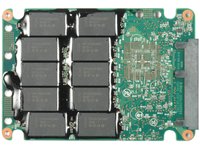Intel’s X25-E SSD Walks All Over The Competition
The X25-E Enterprise SSD
Intel's enterprise-class SSD looks like its mainstream brother, the X25-M, and in fact it is not totally different. The firmware and flash memory are different, of course, as the X25-E is based on fast SLC flash memory chips, while the X25-M incorporates cheaper MLC flash. This has a direct impact on capacity. While the X25-M is available at 80 GB and 160 GB capacity points, the X25-E is limited to 32 GB and 64 GB for now. However, a 128 GB model is on the roadmap for Q4/2009, by which time the mainstream X25-M is expected to reach 320 GB. These higher capacities will be possible once flash memory production can be switched from today’s 50 nm manufacturing process to the next generation 34 nm process.
Sharing The Same Basis
We opened up both products and found the same Intel controller and DRAM chip, the latter serving as internal cache memory. Some people may complain, but this approach makes sense from an economic standpoint. We prefer to have a look at the actual results rather than the approach taken, and as already mentioned, the results are impressive.
SATA Not Ideal
The X25-E drives still have a weakness that may prevent them from being deployed into true enterprise environments: they are still only based on the Serial ATA interface, while Serial Attached SCSI (SAS) has become the standard in enterprise environments. SAS provides important features, such as expanders and dual data ports, which can be used to maximize performance or redundancy. That said, this isn’t a serious issue, as SAS supports STP, the SATA Tunneling Protocol, which allows you to connect Serial ATA hard drives to SAS controllers.


Impressive Performance and Efficiency
While the X25-M is limited to 75 MB/s write throughput, the X25-E drive does not have this bottleneck, and provides write performance that is not too far away from its read performance. If you’re interested in I/O performance—which is the main reason for creating such a drive—you can expect a performance increase of 10x to 25x when compared to a fast 15,000 RPM hard drive. There is a performance boost of between 30% and 5X when compared to other enterprise flash SSDs. And as if this were not enough, the X25-E requires even less power than any of the other solutions to deliver its impressive performance.
Get Tom's Hardware's best news and in-depth reviews, straight to your inbox.
Write Amplification Kept In Check
In examining this new drive, we also had a look at an issue known as write amplification. Since flash memory has to be written in blocks, writing a small amount of data causes a write operation of at least a certain block size, which may be 64 KB, 128 KB or even more. As a result, multiple small writes may take a lot of time, as the entire block has to be rewritten. This not only creates performance issues, but also may become an issue for long term reliability.
Performance concerns not only focus on low write performance, but also on changing performance characteristics. Flash controllers may adjust to suit high I/O or high throughput operation; maximizing one can affect the other. Intel’s flash SSD controller utilizes a DRAM cache memory, among other things, to reduce write amplification, and we found that the performance of the X25-E is pretty balanced indeed. Writes neither take considerably longer than reads, nor did we find varying performance when we tested I/O performance after lots of sequential operation or vice versa. Let’s look at the results.
| Manufacturer | Intel |
|---|---|
| Family | X25-E |
| Model Number | SSDSA2SH032G1GN |
| Capacity | 32 GB |
| Other Capacities | 64 GB |
| Rotational Speed (RPM) | n/a |
| Platter | - |
| Interface | SATA/300 |
| Cache (MB) | 16 MB |
| NCQ | Yes |
| Height | 6.5 mm |
| Weight | 78 g |
| MTBF | 2 Million Hours |
| Operating Temperature | 0-70°C |
| Specified Idle Power (low-power) | 0.06 W |
| Measured Idle Power (low-power) | 0.04 W |
| Operating Shock (2 ms, read) | 1,000 G |
Current page: The X25-E Enterprise SSD
Prev Page They Did It Again: X25-E For Servers Takes Off Next Page Test Setup, Transfer Diagram
